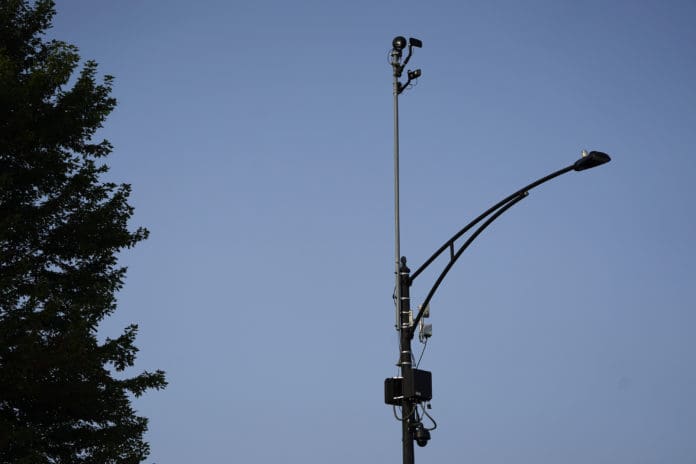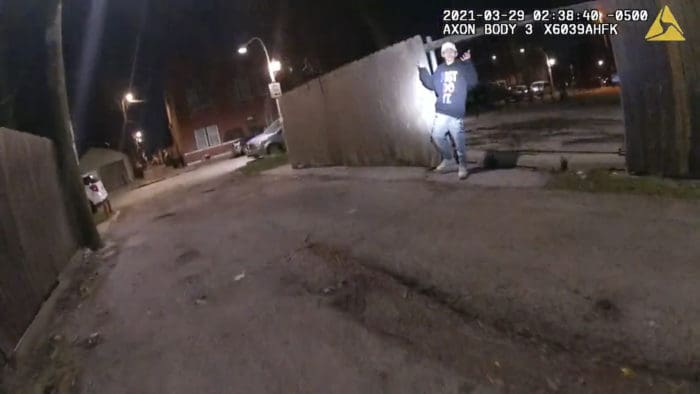
By Don Babwin and Garance Burke, AP
A gunshot detection system that has cost Chicago tens of millions of dollars and is touted as a critical component of the police department’s effort to combat gun violence rarely produces evidence of gun-related crime in the city, Chicago’s nonpartisan watchdog agency concluded.
In a scathing report released Tuesday, the Office of Inspector General’s Public Safety section said the police department data it examined “does not support a conclusion that ShotSpotter is an effective tool in developing evidence of gun-related crime.” And, the office concluded, if the department has information that shows ShotSpotter plays a key role in developing such evidence, its “record-keeping practices are obstructing a meaningful analysis of the effectiveness of the technology.”
The inspector general’s office found that between Jan. 1, 2020, and May 31 of this year, over 50,000 ShotSpotter alerts were confirmed as probable gunshots, but that actual evidence of a gun-related crime was found in about 4,500 instances, or only about 9%.
The report is the latest blow to a system that has come under scrutiny, particularly in Chicago, after it set in motion the fatal police shooting of 13-year-old Adam Toledo in March. Although the boy appeared to be holding a gun right before police shot him, community groups argued afterward that the system sends officers to predominantly black and Latino neighborhoods for “unnecessary and hostile” encounters with residents and asked a judge to scrutinize the algorithm-powered technology to determine if it is trustworthy.
Last week, The Associated Press reported that its review of thousands of internal documents, emails, presentations and confidential contracts, along with interviews with dozens of public defenders in communities where ShotSpotter has been deployed, found serious flaws in the use of ShotSpotter as evidentiary support for prosecutors.
According to the AP investigation, the system can miss live gunfire right under its microphones and misclassify the sounds of backfiring cars or fireworks as gunshots. It also found that forensic reports prepared by ShotSpotter employees have been used in court to improperly claim that a defendant shot at police, or provide questionable counts of the number of shots allegedly fired by defendants. Judges in a number of cases have thrown out the evidence.
Chicago prosecutors partially relied on audio evidence picked up by ShotSpotter sensors to charge 65-year-old Michael Williams with murder last year for allegedly shooting a man inside his car. Williams spent nearly a year in jail, but late last month a judge dismissed his case at the request of prosecutors, who said they had insufficient evidence.
Following the AP investigation, Democratic Sen. Ron Wyden, of Oregon, said he U.S. Justice Department needs to look into whether the algorithm-powered police technologies it funds, including some that integrate gunshot detection data, contribute to racial bias in law enforcement.
ShotSpotter vigorously defended the reliability and validity of its system on Tuesday, and pointed to an audit that the company commissioned to study the effectiveness of its technology.
“The OIG report does not negatively reflect on ShotSpotter’s accuracy which has been independently audited at 97 percent based on feedback from more than 120 customers,” ShotSpotter said in a statement.
Chicago Police Department spokesman Tom Ahern said Tuesday that ShotSpotter has detected hundreds of shootings that otherwise would have gone unreported.
“The system gives police the opportunity to reassure communities that law enforcement is there to serve and protect them and helps to build bridges with residents,” Ahern said.
The American Civil Liberties Union, meanwhile, published a blog post critiquing ShotSpotter’s system that cited the AP’s investigation.
“ShotSpotter’s methodology is used to provide evidence against defendants in criminal cases, but isn’t transparent and hasn’t been peer-reviewed or otherwise independently evaluated,” wrote Jay Stanley, a senior policy analyst at ACLU’s Speech, Privacy and Technology Project. “That simply isn’t acceptable for data that is used in court.”
In San Diego, the city council was set to vote last month on renewing its own contract with ShotSpotter and instead decided to send it to staff for further review after community activists raised questions about its use.
Chicago’s Office of Inspector General is a taxpayer-funded independent watchdog that has subpoena power but no authority to change or eliminate city programs.
According to the OIG report, late last year the police department asked for and received an extension of its three-year, $33 million ShotSpotter contract, the company’s largest, that was set to expire this month. The city “exercised an option to extend it, setting a new expiration date for August 19, 2023,” it said.
Some aldermen expressed surprise that Mayor Lori Lightfoot’s administration renewed the contract, with one saying he would introduce an ordinance requiring City Council approval on the renewal of any contract over $1 million. Lightfoot’s office did not immediately respond to a request for comment.
ShotSpotter has won praise from law enforcement agencies that say it puts officers on the scene far faster than if they had waited for someone to call 911 to report gunfire. While, for example, there have been questions about whether the police shooting of Toledo was justified, authorities said that an instant before he was shot, the teen was holding a gun that another man had fired minutes earlier.

Lightfoot has weighed in as well, calling the technology, along with cameras and high-tech support centers staffed with police, “a lifesaver.”
On its website, the California-based company says ShotSpotter helps stop gun violence by using “sensors, algorithms and artificial intelligence” to classify 14 million sounds in its proprietary database as gunshots or something else. In a recent interview, CEO Ralph Clark declined to discuss specifics about the company’s use of artificial intelligence, saying it’s “not really relevant,” and instead emphasizing the importance of ShotSpotter employees, who listen to sounds picked up by the sensors and help classify them.
According to the inspector general’s report, the use of the ShotSpotter system is “changing the way officers respond to calls,” and is being used “to form the basis for an investigatory stop or as part of the rationale for a pat down once a stop has been initiated.”
“If the Department is to continue to invest in technology which sends CPD members into potentially dangerous situations with little information — and about which there are important community concerns — it should be able to demonstrate the benefit of its use in combatting violent crime,” the office reported. “The data we analyzed plainly doesn’t do that.”




You want to lessen crime? Remove restrictions on citizens carrying guns. And refund the police. More guns on more honest folks hips and the crime rate will drop.
Exactly. There will be an initial uptick in shootings as the Cleanse commences and criminals go through the necessary learning curve, but they’d soon drop once word spread that the local burglar Tyrone Shoolayces attempted to thug up the wrong person.
We have had the shot spotter system, here in Rochester, NY, for years, at the cost of about $150,000 annually.
The only thing I can see that it does, is the police can find the body 10 minutes sooner than without the system.
We had perimeter systems like this on our Army FOB. I was trained to install them and thought they were mostly useless as echoed reflections or vehicle backfires would confuse the directional sensor. At one time we had it hooked into the perimeter’s airborne security camera, but after multiple false indications that would automatically swing the camera to dead locations, we unhooked and ignored the thing.
No sh*t!! You know who’s doin the shootin, AND we know how to stop it even if you can’t or wont!
$11 million a year (more or less)…Wow! I wonder how much of a kickback Lightfoot is receiving for renewing that contract?
The claims of racial bias in the ShotSpotter implementation seem rather spurious. The system (allegedly) pinpoints specific noises…no matter who or where those specific noises are generated.
The criminal element of Chicago do not appear to be infused with shock and awe regarding SpotShotter [sic]. Last weekend’s final tally (courtesy of hey jack ass) is 9 dead and 42 wounded…a significant increase over preceding years statistics for the same weekend.
And still more than in Kabul according to the Biden Administration.
“Kabul? Kabul? Is something happening in the country of Kabul?” joe biden.
“Kabul? That’s the food I give to Major. A fifty pound sack a week. Where is he anyway? Here Major Major. Here boy. Come get your kabul.”
— Joe Whatshisname.
Could just be a sunken cost to her; Now then Daley taking kickbacks is highly likely considering what we know about IL politics.
Shot spotter is just some feel-good “do somethin’ for the chillen” BS. Breaking: St. Sabina “church” led by Snuffy the child molester is having a fun er gun “buyback” offering $ to gangbangers & stupid folks.
That no-snitch culture will always defeat reactive law enforcement.
Tens of millions of dollars, lol, money well spent.
A technology to identify location of gunfire would be of value, maybe of great value, in quick response to illegal acts in cities. Problem is it has to actually work to a very high level of certainty. This product sounds like the effectiveness is based entirely on two things. The manufacturers false advertising and the job security of those who spent the taxpayer dollars to buy it.
This is similar to how military development projects go off the rails, far over budget and produce weapon systems that fail to meet the need. Bureaucracy, covering one’s ass and assuring profit over performance.
Like moron Sen. Ron Wyden, “Shotspotter” has been know to be useless for MANY years.
One cannot underestimate the great social role of artificial intelligence. And I hope that security businesses will be using it widely soon too. For instance, this Edge AI platform can work splendidly on crown count analysis and make forecasts too. Which means that it can improve not only profits, but overall security too.
Comments are closed.